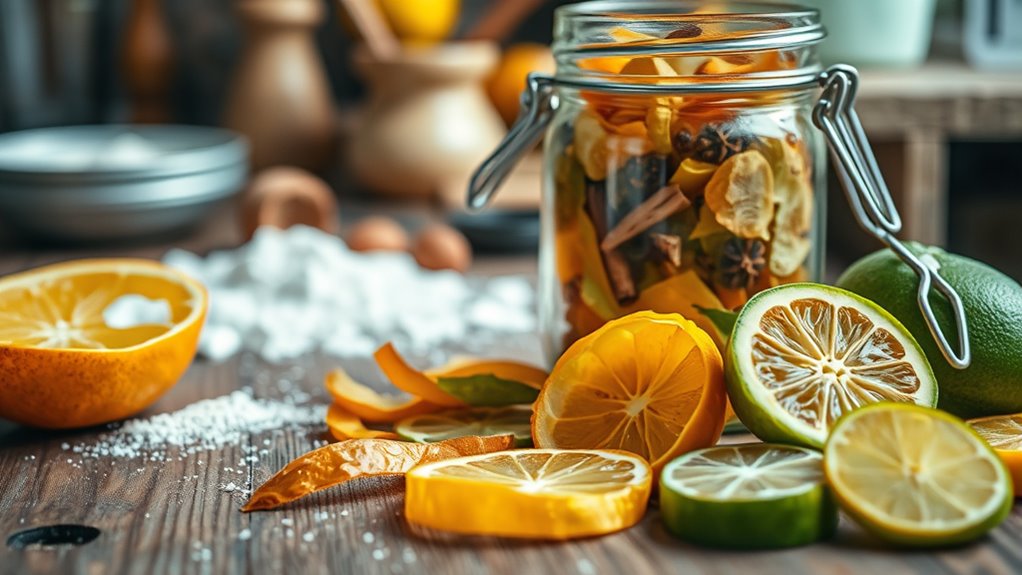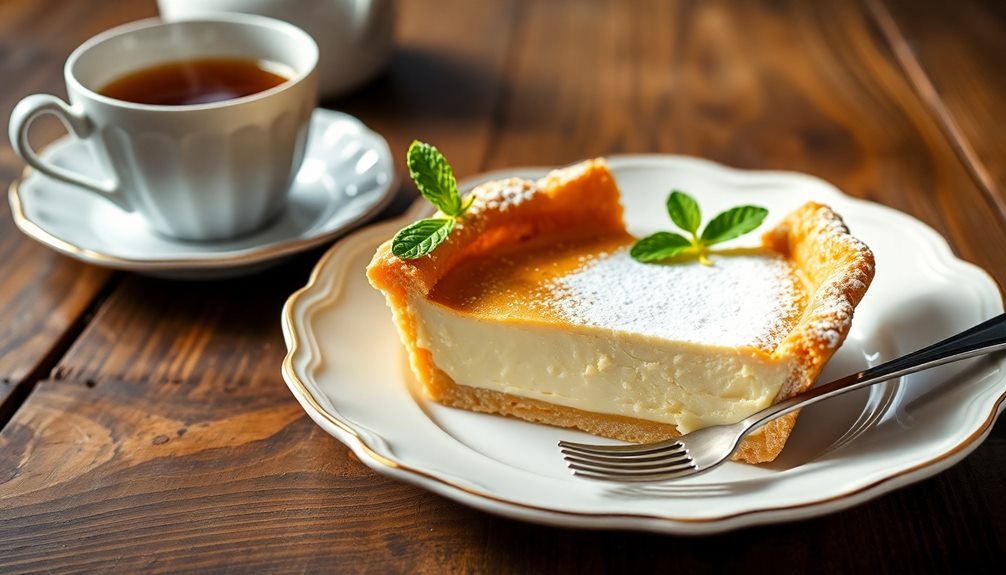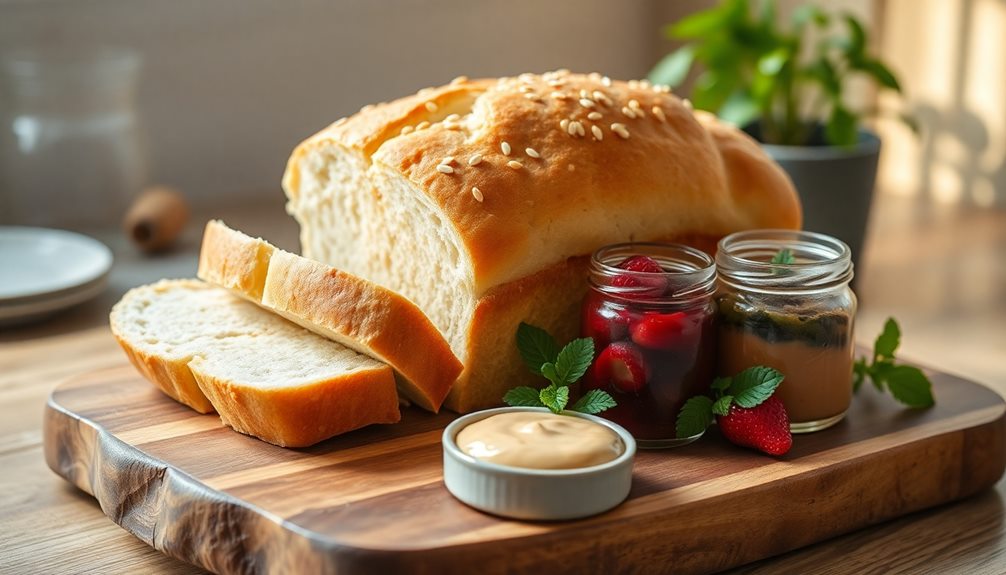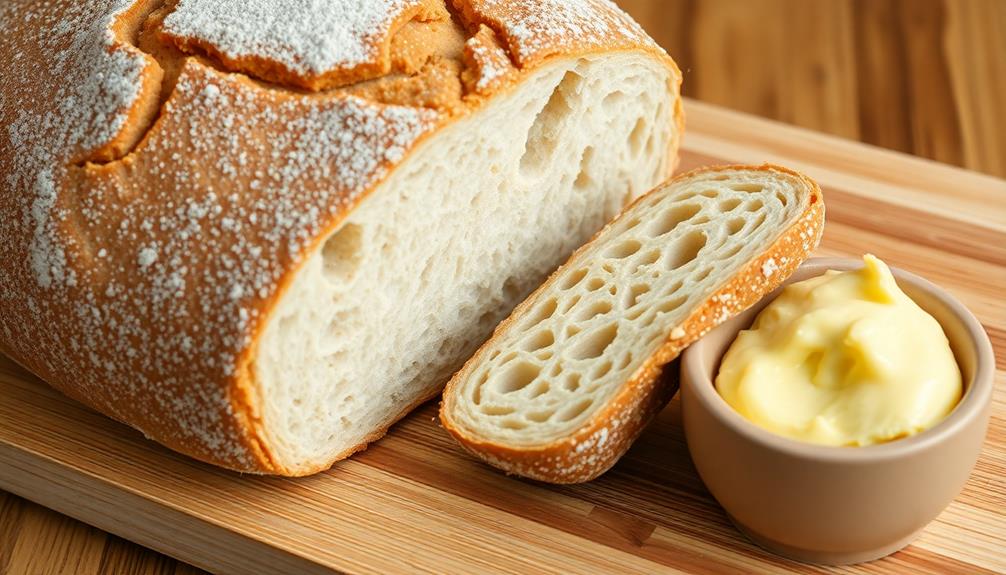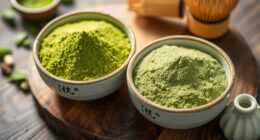You can turn fruit peels into flavor powerhouses by drying and grinding them into zest or powder, infusing oils or syrups, or including fresh zest directly in your baking. This boosts flavor naturally while reducing waste and supporting eco-friendly practices. Compost the scraps afterward to close the loop. Want to discover more ways to maximize your peel’s potential and bake sustainably? Keep exploring to reveal even more eco-conscious baking tips.
Key Takeaways
- Use zesting and infusing techniques to extract maximum flavor from fruit peels before discarding.
- Dry and grind peels into powders or flakes to add natural aroma and taste to baked goods.
- Incorporate infused oils or syrups made from peels to enhance flavor without waste.
- Compost peels properly to create nutrient-rich soil, closing the waste loop sustainably.
- Store and package baked treats in eco-friendly, reusable containers to support zero-waste baking practices.
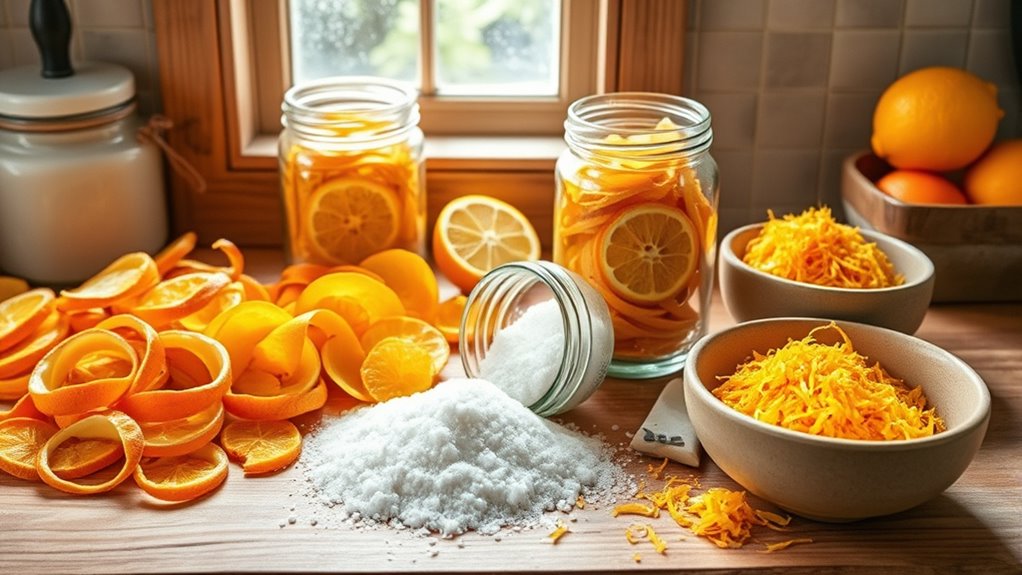
Zero-waste baking is all about creating delicious treats while minimizing environmental impact. One of the simplest yet most effective ways to do this is by turning fruit peels into flavor powerhouses. Instead of tossing peels into the trash or compost bin, you can incorporate them into your baked goods, reducing waste and boosting flavor naturally. To do this effectively, start by exploring composting techniques that guarantee your peels are properly decomposed once used, keeping your kitchen eco-friendly. Composting allows you to recycle organic waste into nutrient-rich soil, closing the loop in your baking process. When you peel fruits like citrus, apples, or pears, consider saving the peels and adding them to your compost bin, which helps nourish your garden or houseplants. Additionally, understanding juice extraction methods from fruits like oranges can inspire new ways to use peels in baking, such as zesting or infusing flavors.
Turn fruit peels into flavor boosters and compost to reduce waste and nourish your garden naturally.
Incorporating sustainable practices into your kitchen routine can further enhance your zero-waste efforts, making your baking even more eco-conscious. However, before composting, you can also process those peels for use in your recipes. For example, dried citrus peels can be ground into zest or powder, adding a vibrant, intense flavor to cakes, cookies, or muffins. You might also infuse oils or syrups with the peels, extracting their aromatic oils to deepen the flavor profile of your baked goods. The key is to minimize waste at every step, and that includes choosing sustainable packaging for your baked treats. Opt for reusable containers, beeswax wraps, or compostable packaging options whenever you share or store your goodies. This approach not only reduces single-use plastics but also supports your overall sustainability goals, making your baking more environmentally responsible. This way, you reduce the reliance on single-use plastics and make your baking more environmentally conscious.
Using fruit peels in baking not only enhances flavor but also aligns with your zero-waste goals. For citrus, the zest is a powerhouse of flavor, so grating the peels before tossing them out maximizes their potential. For dried peels, you can grind them into powders to sprinkle into doughs or fillings, providing a natural, fragrant boost. When you incorporate peels into your recipes, you create layered flavors that are both vibrant and sustainable. Plus, by embracing composting techniques for any scraps or leftover peels, you ensure nothing goes to waste, creating a closed-loop process that benefits your kitchen and the planet.
Frequently Asked Questions
Can Fruit Peel Substitutes Affect Baking Texture?
Using fruit peel substitutes can affect your baking texture, leading to slight texture alteration depending on the substitute’s fiber content. While they might not fully replicate fresh peels, they can still enhance flavor intensity. Keep in mind, some substitutes may change the batter’s consistency, so adjust your ingredients accordingly. Experimenting helps you find the right balance between preserving texture and boosting flavor without compromising your baked goods.
How Long Do Fruit Peel Flavor Infusions Last?
You might worry about flavor loss, but with proper preservation techniques, fruit peel infusions can last several weeks in the fridge or months frozen. The shelf life depends on storage methods; airtight containers and low temperatures slow down degradation. To maximize flavor, use them within 2-4 weeks when refrigerated or up to 6 months when frozen. Regularly check for signs of spoilage to enjoy their vibrant taste longer.
Are There Fruit Peels Unsuitable for Baking?
You might wonder if any fruit peels are unsuitable for baking. Some peels, like those from citrus with peel toxicity, can be unsafe if ingested in large amounts. Avoid using peels intended for non-edible crafts or those treated with pesticides. Stick to organic, edible peels, and always wash thoroughly. This guarantees safety in your baking, preventing any harmful effects from peels not meant for consumption.
What’s the Best Way to Store Leftover Fruit Peels?
Imagine giving your leftover fruit peels a second chance. To keep them fresh, store peels in an airtight container in the fridge or freezer, following peel preservation tips. This not only extends their life but also supports composting benefits by reducing waste. Proper storage guarantees you can enjoy their flavor power later, making your baking more sustainable and flavorful. Keep peels fresh, save them for future use, and contribute to a greener planet.
Can Peel-Based Flavors Replace Extracts in Recipes?
Peel-based flavors can often replace extracts by capturing their unique peel flavor profiles. You can use peel infusion or simmering techniques to extract concentrated flavors, making them suitable for recipes. While they may not perfectly mimic commercial extract strengths, adjusting quantities allows for effective extract substitution techniques. Experiment with different peels to develop complex flavors, and remember, fresh peels bring vibrant, natural aromas that enhance your baked goods naturally.
Conclusion
By turning fruit peels into flavorful ingredients, you’re not just reducing waste—you’re revealing a secret baking hack. Some say that the oils and aromas trapped in peels can actually boost your baked goods’ flavor more than the fruit itself. So next time you peel an orange or lemon, think twice before tossing it. You might just discover that zero-waste baking isn’t only eco-friendly but also a delicious game-changer in your kitchen.
